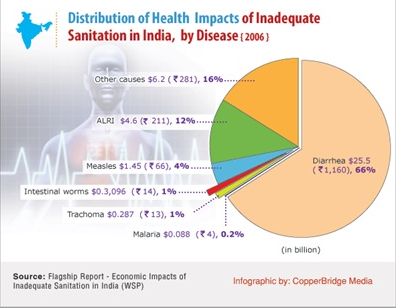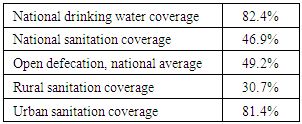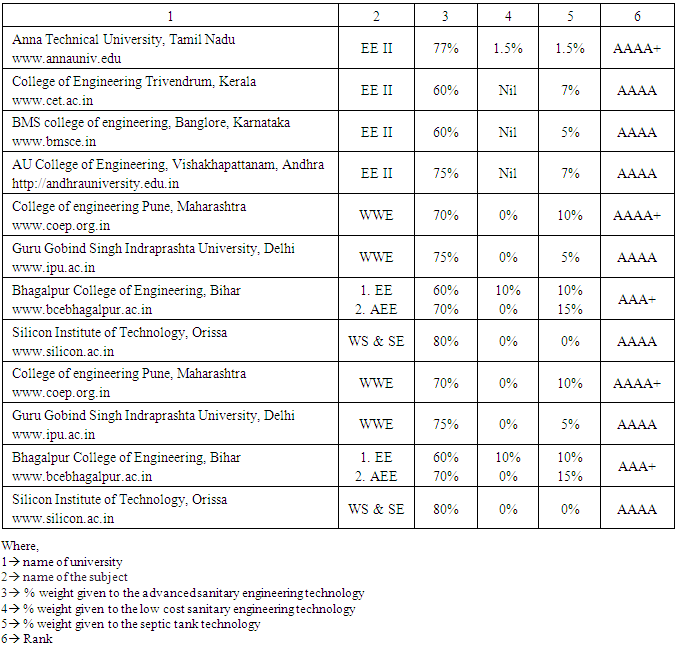-
Paper Information
- Next Paper
- Paper Submission
-
Journal Information
- About This Journal
- Editorial Board
- Current Issue
- Archive
- Author Guidelines
- Contact Us
American Journal of Environmental Engineering
p-ISSN: 2166-4633 e-ISSN: 2166-465X
2016; 6(6): 184-187
doi:10.5923/j.ajee.20160606.04

Curriculum of Sanitary Engineering in Universities of India: Vis-À-Vis Requirements of Modern India
M. Husain1, K. S. Wani1, S. Sugandhi2
1SSBT’s College of Engineering and Technology, Bambhori, Jalgaon, India
2Jawahar Institute of Technology, Borawan, Khargone, India
Correspondence to: M. Husain, SSBT’s College of Engineering and Technology, Bambhori, Jalgaon, India.
| Email: |  |
Copyright © 2016 Scientific & Academic Publishing. All Rights Reserved.
This work is licensed under the Creative Commons Attribution International License (CC BY).
http://creativecommons.org/licenses/by/4.0/

In-sanitation is the prime cause of diseases in India. In India public health and environmental cost due to unsafe sanitation consumes 60% of its gross domestic production. The problem has got roots in the socio-economy, culture and even administration. The government of India launched several comprehensive cleanliness programs. They are aimed to provide sanitation facilities to every countryman. Nevertheless the statistics shows that the successes of the programs are low. The successful implementation of the sanitation program requires technological input. This input is given by sanitary engineers. The curriculum of sanitary engineering must be designed to prepare engineers to tackle the specific indigenous sanitation problems. To analyze whether the curricula of Indian universities meet this requirement, the curricula of sanitary engineering of various esteemed Indian universities/institutions have been examined here. It is found that the curriculums do not meet the specific technological requirements of the country. They include the technology which is suitable for the developed countries but it is unable to train the engineers to meet the specific indigenous requirement. Here, suggestions are given to suitably modify the curriculums as per the native requirements. The present study especially refers to India, yet has due relevance to the all third world countries.
Keywords: Sanitation, Engineering, University Curriculum
Cite this paper: M. Husain, K. S. Wani, S. Sugandhi, Curriculum of Sanitary Engineering in Universities of India: Vis-À-Vis Requirements of Modern India, American Journal of Environmental Engineering, Vol. 6 No. 6, 2016, pp. 184-187. doi: 10.5923/j.ajee.20160606.04.
Article Outline
1. Introduction
- Modern humans (Homo sapiens) have dwelled on this earth for some 200 000 years. The earliest known permanent settlement, which can be classified as urban, is Jericho from 8000–7000 B. C.. Harappa Civilization, 2800 B. C., had world's earliest known system of flush toilets. These existed in many homes, and were connected to a common sewerage pipe. The first evidence of the purposeful construction of the water supply, bathrooms, toilets and drainage in Europe comes from Bronze Age Minoan Crete in the second millennium B.C. [1]. However the sanitation scenario in modern India is not bright. In modern India over 85% diseases can be directly linked to the insanitation. Figure 1 shows health impact of poor sanitation [2].
 | Figure 1. Health impact of insanitation in India |
 | Figure 2. Impacts of insanitation in India |
|
2. Curriculum of Sanitary Engineering
- Sanitary engineering is included in the curriculum of civil engineering under graduate course which is a four year course in most of the universities in India. There are two courses of sanitary engineering in the civil engineering curriculum. These courses are respectively water supply engineering, and wastewater engineering. Generally these courses are at third year and final year level respectively. These courses are also named as public health engineering (I & II) or environmental engineering (I & II) etc. The topics of sewage collection and treatment are included in the curriculum of wastewater engineering. Here, the curriculum of wastewater engineering of some major universities has been analyzed. The analysis is done with reference to the relative weight given to the topics of advanced wastewater engineering, and low cost sanitary engineering. Amongst low cost sanitary engineering technology, septic tank is also important. In rural as well as urban areas, where water carriage system is used but the sewerage network is not available, septic tank is the most commonly used technology. Hence it is also an important technology in Indian context.The observations of curriculum analysis are summarized in table 2. The curriculum of sanitary engineering contains some general topics like characterization of sewage and its pollution effects etc. It also includes wastewater collection, removal and treatment technology. In the present analysis, the onsite disposal technology like dry privy or eco-toilet etc is considered as low cost sanitary technology. Sewerage network design and treatment by advanced methods activated sludge, trickling filter etc is considered as advanced sanitary engineering. The relative weight given by various institutes to low cost technology and advanced technology is determined.
3. Sampling Methodology
- The selection of universities and engineering institutions is done based upon the following criteria: Sharma and Chandra [6] have done a survey of technical institute of India. They have ranked the institutes in following categories- AAAAA (Exceptional), AAAA+ (Outstanding), AAAA (Very good), AAA+ (good), AAA (Above average), AA+ (Fair), AA (Average), A+ (Pass), A (Improve). They have considered quality of students, research output, industry interface, refereed publications and academic productivity. Out of this, institutes of rank AAAAA, AAAA+, AAAA, and AAA+ are sampled. Care is taken that the universities and colleges are uniformly distributed across the geography of the country.
|
4. Conclusions
- It is clear from the observations of table 2 that the curriculums of sanitary engineering of Indian universities/ engineering institutes have given most of the emphasis on water carriage systems, sewerage network and advanced wastewater treatment systems. The emphasis given to septic tanks and low cost excreta disposal technology is very less. Whilst, they are the actual need of the country. The sanitary engineers of India must be well versed with the technology that may provide solution to localities having no sewer network or open defecation problems. These topics are either missing in the curriculums or are given too little weight. The curriculum teaches a technology which is not in practices, rather inappropriate for the environment in which it has to be applied. Of course, with time as the country will transform to a developed country, it will also adopt the same advanced technology. Yet the country has to undergo a long journey from a developing country to a developed country. At this juncture of time it needs low cost sanitary engineering technology. Hence it is recommended that the universities must amend their sanitary engineering curriculums accordingly. It is important to be noted that low cost sanitary technology will be developed by indigenous research only as it is an exclusively indigenous requirement. The academicians and university statuary bodies must consider the issue very seriously. The curriculums must be soon amended appropriately. This is an important step the country will have to take as it has to transform to a developed country.
 Abstract
Abstract Reference
Reference Full-Text PDF
Full-Text PDF Full-text HTML
Full-text HTML
